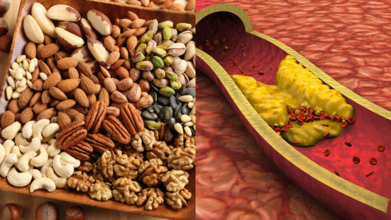- Health Conditions A-Z
- Health & Wellness
- Nutrition
- Fitness
- Health News
- Ayurveda
- Videos
- Medicine A-Z
- Parenting
- Web Stories
How Sleeping On Your Side Prevents Back Soreness

Image Credit: Canva
A restful night of sleep is essential to ensure a healthy body and mind, yet waking up with sore back muscles or discomfort is a common problem for many people. While sleeping on one's back has long been described as the best position, recent findings may indicate that sleeping on the side is an even better option for preventing back pain and general wellness. However, to benefit from side sleeping, proper alignment and posture are essential.
Side sleeping has been noted for its potential health benefits, especially in older adults and those with higher body mass indices. It tends to improve spinal alignment when done correctly, reducing pressure on the lower back, shoulders, and neck. Misalignment negates these benefits, thus the importance of proper technique.
In addition, side sleeping is not just a comfortable position. It is a practical position that helps in relieving a number of health problems, from back pain to sleep apnea. If one understands the subtleties of this posture, he or she can make informed adjustments to their sleep routines.
Benefits of Sleeping on Your Side
1. Relief from Back and Joint Pain
Side sleeping will help preserve the natural curvature of the spine, reducing pressure on the lower back and hips. This is also helpful to those who have chronic conditions like fibromyalgia, as it often affects wide-ranging musculoskeletal pain. A pillow placed between the knees will also aid in alignment as it prevents hip and knee joints from collapsing.
2. Reduced Snoring and Sleep Apnea Symptoms
Obstructive sleep apnea, characterized by disrupted breathing during sleep, can lead to serious complications like hypertension and heart disease. Sleeping on your side minimizes airway obstructions, thereby reducing snoring and improving oxygen flow. This can significantly enhance sleep quality and overall health.
3. Improved Digestive Health
Side sleeping, particularly on the left side, helps support optimal digestive function. This position allows for natural waste flow and minimizes the occurrence of gastrointestinal issues like acid reflux, heartburn, and bloating. In individuals with constipation, side sleeping can help encourage better bowel movements through smoother intestinal activity.
4. Better Brain Health
Another lesser-known benefit of side sleeping is its effect on brain health. Researchers indicate that this position can help the brain perform its natural detoxification more effectively by removing waste products from the brain during sleep. This process, known as glymphatic drainage, is very important for cognitive function and may help to lower the risk of neurodegenerative diseases.
Potential Drawbacks of Sleeping on your Side
Although the benefits of side sleeping are great, this position has some disadvantages. The most prominent one is shoulder pain. Long-term sleeping on one side can cause the corresponding shoulder to sink into the mattress and cause misalignment and pain.
To avoid this:
- A medium-firm mattress should be chosen, which will provide support.
- Use a firm pillow to keep the head aligned with the shoulders.
- Consider alternating sides throughout the night to prevent prolonged pressure on one shoulder.
Another issue is neck pain, often caused by tucking the chin into the chest or improper head placement. Keeping the head neutral and in line with the spine is key to avoiding discomfort.
Left Side vs. Right Side: Which Is Better?
Many tout left side sleeping as the healthier of the two due to some special benefits: pressure on the heart is alleviated, and digestion is aided as stomach acids are better permitted to flow naturally. But on the right side can sometimes be helpful, especially if an individual is a chronic lower back pain or suffering from obstructive sleep apnea.
Ultimately, the best side for sleeping is a personal need for health. Try both sides and listen to what your body is saying for how it feels to best sleep on one side or the other.
Best Practices to Maximize Side Sleeping
A person can maximize the benefits of side sleeping by minimizing discomfort by following some guidelines.
Choose the right mattress and pillow: The ideal support and comfort is given by a medium-firm mattress. Pair it with a firm pillow to keep the neck and spine aligned.
- Mind your alignment: Lying on your side, ensure that your ears are in line with your shoulders, and your chin remains neutral. Do not tuck your chin into your chest.
- Support Your Knees: Placing a pillow between your knees prevents hip and knee joint collapse, and this maintains a good spinal curvature.
- Lifting Your Knees Slightly: Slightly bending your knees towards your chest helps in reducing the pressure exerted on the lower back.
- Monitor Hand and Arm Placement: Keep your arms below your face and neck, parallel to your body, and avoid strain.
While side sleeping has many benefits, sometimes your body needs to change positions at night. Alternating from one side to the other or even just briefly lying on your back can help avoid pressure points and ensure overall comfort. Stomach sleeping should be avoided because it puts too much stress on the spine and internal organs.
It's not just a comfortable way to sleep; it is more proactive about your better health. From alleviating back pain to improving digestion and brain health, the list is too long. Adopting proper alignment techniques and investing in the right sleep accessories makes it transformable in your night routine.
Whether you're a long-time side sleeper or have just begun, keep in mind that tiny changes may make a huge difference. It's not about being right or wrong, but instead, applying the correct techniques to get you feeling fresh, pain-free, and ready to go after a full night's sleep.
A 4-Step Science-Backed Routine That Works for Every Skin Type

There was a time when skincare felt like a competitive sport. People layered acids, scrubbed their faces raw, and measured success in stings, peels, and redness. But times are changing. A new, science-backed wave is sweeping in, one that values results without leaving your skin feeling like it has been through a survival reality show.
From Shelf Overload to Skincare Simplicity
For years, we’ve been told more is better. More products, more steps, more actives, until our bathroom shelves looked like mini-pharmacies. But skin, much like us, thrives in balance. Aggressive routines may deliver quick wins, but they often come with side effects like irritation, dryness, or breakouts that weren’t invited to the party.The modern approach is a gentler, more measured one: using well-formulated products that are kind to the skin barrier but still pack enough punch to make a visible difference. And the best part? You only need a few steps, not a 12-item shopping list.
The Four Steps That Actually Work
Malini Adapureddy, Founder of Deconstruct Skincare, swears by a routine that’s simple enough to remember before coffee and effective enough to see results in weeks. Designed for Indian skin and climate, this four-step method covers the essentials: cleansing, treating, moisturising, and protecting.
Step 1: The Clean Slate
Every story starts somewhere, and for your skin, that’s cleansing. But the goal isn’t to strip your face like it’s a frying pan that’s just seen a masala spill. A gentle oil-control face wash with salicylic acid and niacinamide is the ticket. Salicylic acid slips into pores to keep them clear, while niacinamide calms and balances.Step 2: The Targeted Glow Shot
Once the canvas is prepped, it’s time for the serum stage. Enter a 10% vitamin C serum with 0.5% ferulic acid. Vitamin C is your radiance best friend, helping to fade pigmentation and even out skin tone, while ferulic acid boosts its stability and antioxidant power. Together, they help defend against environmental stressors and bring your complexion back from the land of dull.Unlike some actives that feel like they’re burning through your soul, this combination is gentle enough for daily use.
Step 3: The Barrier Hug
Moisturiser is often seen as the “optional” step, especially if you have oily skin. But hydration isn’t just about adding water; it’s about locking it in. A lightweight, oil-free moisturiser with natural moisturising factors (NMF) and panthenol keeps your skin barrier happy. It helps reduce sensitivity, supports repair, and works in harmony with your actives. And in India’s hot, humid, sometimes dusty climate, that’s a much-needed shield.Step 4: The Non-Negotiable
Sunscreen. Always sunscreen. Whether you’re outside chasing errands or inside chasing deadlines, UV damage is sneaky. It causes pigmentation, speeds up ageing, and undoes all the hard work your serum and moisturiser put in. A broad-spectrum, gel-based sunscreen keeps things light, non-greasy, and comfortable, even under makeup.Why Gentle Works Better Than You Think
There’s a myth that 'strong' means 'effective'. In reality, harsh products can damage your skin barrier, leaving it inflamed and reactive. Gentle formulations, when done right, work gradually but deeply. They’re like the friend who doesn’t shout advice but still changes your life.Consistency is the secret here. When your skin isn’t constantly fighting irritation, it can focus on repairing itself, building resilience, and looking better over time.
What Is Pulmonary Fibrosis and Why That Annoying Cough Might Be More Than Just a Cold

Credits: Canva
If you’ve been coughing for weeks, blaming it on “lingering winter sniffles” or chalking it up to “just getting older,” it might be time to step away from the cough syrup and lean in for some uncomfortable truth. Your cough could be more than a seasonal annoyance. In rare but serious cases, it could be a red flag for a life-limiting condition called pulmonary fibrosis.
What is Pulmonary Fibrosis?
In plain terms, “pulmonary” means lungs, and “fibrosis” means scarring. It’s a serious, progressive condition where lung tissue becomes scarred and stiff, making it increasingly hard to breathe.
Reportedly, there’s currently no cure. Treatments exist, but they mainly slow down the damage rather than reverse it. The sooner you get diagnosed, the better your chances of managing symptoms and that’s where spotting the signs early is crucial.
Symptoms to Watch For
- Shortness of breath (especially when climbing stairs or speed-walking to catch the bus)
Why That Cough Happens
Coughing is your body’s bouncer, booting out anything that might harm your lungs — dust, smoke, rogue crumbs, the works. The process involves your vocal cords clamping shut, then snapping open with a burst of air.
With pulmonary fibrosis, this reflex can get stuck on a loop. Coughing irritates the vocal cords, which makes you cough more, which irritates them further, a vicious cycle that can turn even a quiet cup of tea into a coughing fit.
The Four Flavours of Cough
- Acute cough – Lasts less than three weeks; often tied to infections or irritants.
Coughs can also be:
- Dry/unproductive – Triggered by things like temperature changes, dusty air, or laughing.
Who’s More at Risk?
While pulmonary fibrosis can happen to anyone, your risk might be higher if you:
- Are over 50
Managing the Cough
A pulmonary fibrosis cough often doesn’t respond to standard cough medicines. Instead, treatment usually focuses on easing symptoms and improving quality of life.
Your doc may recommend alternative medications used for chronic cough in other conditions. These don’t cure the scarring but can make the coughing less intrusive. They’ll also want to check for other contributing factors like acid reflux, sinus issues, or side effects from medication, because if those are making things worse, tackling them can help.
Everyday Coping Tricks
While you work with your doctor, you can try a few lifestyle tweaks to manage coughing fits:
- Avoid smoky, dusty, or heavily polluted spaces
Pulmonary fibrosis is rare, but catching it early can mean more treatment options and better management. Plus, you’ll finally know whether your cough is from a stubborn cold or something that needs closer attention. Your cough could be a harmless side effect of a dusty ceiling fan or it could be your body waving a red flag.
Scientist Reveals the Tiny Foods That Can Transform Your Cholesterol in Just 10 Days

If you’ve ever stared at a packet of mixed nuts wondering whether to sprinkle them over your porridge or just eat them by the handful, here’s your permission slip: go for it. According to Dr Sarah Berry, a professor at King’s College London and Chief Scientist at ZOE, nuts and seeds are not just snackable; they are good for cholesterol crunching. In fact, swap some of your less healthy fats for these nutritional powerhouses, and you could lower your cholesterol by up to 10 per cent in just 10 days. That is faster than most fad diets.
The 10-Day Cholesterol Challenge
High cholesterol often feels like one of those invisible problems, until it suddenly is not. It can quietly build up in your arteries, increasing the risk of heart attacks and strokes. But Dr Berry, during an appearance on the Zoe podcast, said that you can make a real difference in under two weeks by tweaking, not overhauling, your diet. It’s not about eating less fat; it’s about eating the right kind of fat.
And this is where most people get it wrong. “Don’t do a low-fat diet,” Dr Berry warns, calling the idea “radical” to anyone still following decades-old advice. Instead, aim for a moderate-fat diet rich in polyunsaturated and monounsaturated fats—exactly the kinds you’ll find in nuts, seeds, and certain oils.
Why Low-Fat Diets Miss the Point
It is tempting to think cutting fat will cut cholesterol, but Dr Berry explains that’s a trap. Not all fats are bad. Saturated fats, found in red meat and some processed foods, can push LDL cholesterol—often dubbed “bad” cholesterol—into dangerous territory. But polyunsaturated fats, abundant in seeds, seed oils, and many nuts, do the opposite.
Simply adding nuts to your meals, whether as a snack, salad topping, or nut butter, can slash LDL cholesterol by 5 to 10 per cent. You have to make a swap. This benefit comes from replacing “harmful” fats, like those in certain animal products and fried foods, with healthier plant-based fats.
Seeds: The Cholesterol Fighters
Sunflower seeds, flaxseeds, chia seeds—they’re all loaded with polyunsaturated fatty acids that support heart health. Stir them into yoghurt, blend them into smoothies, or scatter them over roasted veggies. You’ll barely notice the extra effort, but your arteries will thank you.
Seed oils, like sunflower and flaxseed oil, can also be smart choices in moderation, adding healthy fats to your cooking without the cholesterol-raising impact of certain animal fats.
Rethinking Dairy, Meat, and Carbs
Dr Berry isn’t out to demonise all animal products. Fermented dairy like yoghurt and cheese gets a surprising green light. These foods, she says, don’t have the cholesterol-raising effect you might expect from their saturated fat content. That’s not permission to live on brie and cheddar, but it is a reason to stop fearing your cheese board.
Red meat, however, is a different story. Packed with saturated fats, it’s a direct contributor to rising cholesterol levels. Swapping steak nights for lentil stews or chickpea curries a couple of times a week could make a noticeable difference to your numbers.
Then there’s the carbohydrate conundrum. The real trouble lies with refined carbs like white bread, white rice, and sugary snacks. These are rapidly processed by your body and can be converted into triglycerides, which worsen cholesterol profiles. But whole grains are firmly in the “good for you” column. Wholegrain bread, brown rice, oats, and quinoa can help improve cholesterol levels when they replace the refined stuff.
Building Your 10-Day Cholesterol Menu
Swap your morning white toast for porridge topped with walnuts and chia seeds. Your mid-morning biscuit could become a small handful of almonds. At lunch, toss sunflower seeds into your salad, and use olive or sunflower oil for dressing. Dinner might feature grilled salmon or chickpeas instead of steak, with a side of quinoa instead of white rice.
Why This Works So Fast
Cholesterol levels can be surprisingly responsive to dietary changes. LDL cholesterol particles are constantly being produced and cleared from your bloodstream. When you replace saturated fats with healthier fats, you improve your body’s ability to remove LDL cholesterol. Combine that with reducing refined carbs and upping your wholegrain intake, and the improvement can be measurable in just days.
Dr Berry’s advice is refreshingly realistic: no calorie counting, no extreme restrictions, just sensible swaps. It’s about building habits you can maintain beyond the initial 10 days, keeping your cholesterol low for the long haul.
Forget the idea that lowering cholesterol means bland food and joyless salads. With nuts, seeds, and the right fats, you can eat deliciously and still give your heart a health boost in record time.
© 2024 Bennett, Coleman & Company Limited

